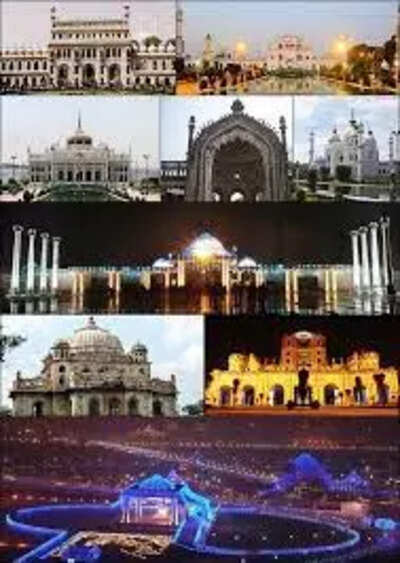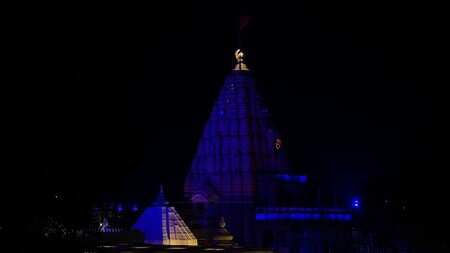A Guide to Historical Places in Lucknow
Times of Bennett | Updated: Apr 06, 2023 10:43

By Anushka Agrawal
Lucknow is a city that is steeped in history and culture. It has been the seat of power for many great empires and dynasties, and has seen many rulers and conquerors come and go. Today, the city is a vibrant mix of old and new, with modern buildings standing alongside ancient palaces and monuments. Despite its rich history, many of Lucknow 's historical places are often overlooked by tourists and residents alike. In this post, we will uncover the hidden gems of Lucknow's historical places that you may have missed out on. From the impossibly beautiful Bara Imambara to the grand and imposing Rumi Darwaza , we will guide you through the city's most fascinating and lesser-known historical sites. Get ready to discover the secrets of this ancient city, and explore the many wonders that are waiting to be uncovered.
Bara Imambara: The crown jewel of Lucknow's architecture
When it comes to historical places, Lucknow is a city that never fails to impress with its architectural wonders. The Bara Imambara is one of the most iconic landmarks of the city and a must-visit for anyone interested in history and architecture. Also known as the Asafi Imambara, this monument was built in 1784 by Nawab Asaf-ud-Daula as a relief measure for the famine-stricken population of Awadh.
The Bara Imambara also houses the Asafi Mosque, which is one of the largest mosques in India. The mosque has a capacity of over 20,000 people and is a fine example of the Mughal style of architecture. The monument is also home to a large step-well and a beautiful garden that adds to the charm of the place.

Visiting the Bara Imambara is a truly immersive experience that takes you back in time and gives you a glimpse into the rich history and culture of Lucknow. It is a sight to behold and a must-visit for anyone visiting the city.
Chota Imambara: The smaller yet magnificent monument
The Chota Imambara is a historical monument located in the heart of Lucknow, Uttar Pradesh. It was built byMuhammad Ali Shah , the third Nawab of Awadh in the year 1838, and is regarded as one of the most stunning architectural marvels of the city.
The monument is also known as the Hussainabad Imambara, and it is smaller than the grand Imambara of Lucknow, but it is no less magnificent. The Chota Imambara is known for its intricate carvings and beautiful decorations that have stood the test of time.
One of the most eye-catching features of the Chota Imambara is its large silver chandeliers which are lit up during special occasions and festivals. The monument also houses a stunning collection of rare Islamic artifacts, including the tazia, which is taken out in a grand procession during the annual Muharram festival.

The monument has a beautiful garden and a large pond that adds to its charm. Visitors can take a leisurely stroll around the garden and soak in the serene atmosphere while admiring the beauty of the monument.
Visiting the Chota Imambara is an experience not to be missed, and it is a must-visit for anyone exploring the historical places of Lucknow. The impressive architecture and rich history of the monument make it a true hidden gem of the city.
Rumi Darwaza : The forgotten gate of Lucknow
While Lucknow is famous for its historical monuments and landmarks such as the Bara Imambara, Chota Imambara, and the Residency, there are a few hidden gems that are often overlooked by tourists. Rumi Darwaza is one such place that has been forgotten over the years, but it is truly a masterpiece of Mughal architecture that deserves to be recognized.
Built in the 18th century by Nawab Asaf-ud-Daula, Rumi Darwaza is a gateway that stands tall at 60 feet and is constructed entirely of brick and lime. The structure is inspired by Roman architecture and features intricate carvings and designs that are a testament to the craftsmanship of that era. The gate has a huge arched doorway that is surrounded by two smaller arches on either side, and it is crowned with a large cupola that has a lantern on top.
Husainabad Clock Tower: A symbol of Lucknow's engineering genius
One of Lucknow's most iconic landmarks, the Husainabad Clock Tower is a symbol of the city's engineering prowess. This imposing clock tower stands tall in the heart of the city and is an impressive sight to behold. Built-in the late 19th century, it was designed by Roskell Payne, who was also responsible for designing the famous Big Ben clock tower in London.
Made entirely of red brick and embellished with intricate carvings and designs, the Husainabad Clock Tower is an architectural marvel. The tower stands at the height of 67 meters and is adorned with a clock that was once one of the largest in India. The clock's pendulum weighs around 400 kg, and the clock itself is still in working condition today.
Aside from its engineering marvel, the Husainabad Clock Tower has an interesting history. It was built to commemorate the arrival of SirGeorge Couper , who was the Lieutenant Governor of the United Provinces of Agra and Oudh during the British Raj. The clock tower was initially called the Hussainabad Imambada Clock Tower, but it is now simply known as the Husainabad Clock Tower.
Visitors to Lucknow should definitely make a stop at the Husainabad Clock Tower, not just for its historical significance, but also for its stunning architecture and engineering prowess.
La Martiniere College: The Legacy of a French Soldier
Built in the early 1800s, La Martiniere College is one of the most renowned educational institutions in Lucknow. It was founded by Major General Claude Martin, a French soldier who served in the British East India Company. Martin was known for his love for architecture, and he designed the college himself, which makes it a unique piece of architecture. The college is spread across a vast area of 60 acres, and the building is a blend of Indian and European architectural styles, which gives it a distinct look.
Apart from its architectural significance, La Martiniere College is also known for its rich history. During the Indian Rebellion of 1857, the college was used as a makeshift hospital, and many wounded soldiers were treated there. The college also has a museum that displays various artifacts and documents related to its history.
La Martiniere College has produced many notable alumni, including former Prime Minister of India,Jawaharlal Nehru , and several other politicians, bureaucrats, and businessmen. The college is open for visitors during certain hours, and guided tours are available, which give visitors an insight into its rich history and architecture. If you want to experience the legacy of a French soldier and witness the unique blend of Indian and European architecture, then La Martiniere College is a must-visit place in Lucknow.
Residency: The site of Lucknow's historical event
Residency is a historical site located in the heart of Lucknow that played a pivotal role in the history of India. This site is known for the events that took place during the Indian Rebellion of 1857, also known as the First War of Independence, when the Indian soldiers, known as sepoys, revolted against the British East India Company. The Residency was the epicenter of the conflict, and it was here that the British forces took refuge during the Siege of Lucknow which lasted for 87 days.
Today, the Residency stands as a reminder of the bravery and courage of both the Indian soldiers and the British forces who fought during the conflict. The site houses a museum that showcases various artifacts from the rebellion and provides a glimpse into the past. Visitors can see the ruins of the buildings that were destroyed during the siege, as well as the graves of the soldiers who lost their lives.

A visit to the Residency is a must for anyone interested in the history of India. It is a place that provides a glimpse into a turbulent time in the country's past and serves as a reminder of the sacrifices made by those who fought for their beliefs. The site is open to visitors throughout the year, and guided tours are available to provide a deeper understanding of the events that took place here.
In conclusion, Lucknow is a city with a rich and vibrant history, and its hidden historical gems are a testament to that legacy. By taking the time to explore these sites, learn their stories, and advocate for their preservation, we can ensure that they remain a vital part of Lucknow's cultural landscape for years to come.
Bara Imambara: The crown jewel of Lucknow's architecture
When it comes to historical places, Lucknow is a city that never fails to impress with its architectural wonders. The Bara Imambara is one of the most iconic landmarks of the city and a must-visit for anyone interested in history and architecture. Also known as the Asafi Imambara, this monument was built in 1784 by Nawab Asaf-ud-Daula as a relief measure for the famine-stricken population of Awadh.
The Bara Imambara also houses the Asafi Mosque, which is one of the largest mosques in India. The mosque has a capacity of over 20,000 people and is a fine example of the Mughal style of architecture. The monument is also home to a large step-well and a beautiful garden that adds to the charm of the place.

Visiting the Bara Imambara is a truly immersive experience that takes you back in time and gives you a glimpse into the rich history and culture of Lucknow. It is a sight to behold and a must-visit for anyone visiting the city.
Chota Imambara: The smaller yet magnificent monument
The Chota Imambara is a historical monument located in the heart of Lucknow, Uttar Pradesh. It was built by
The monument is also known as the Hussainabad Imambara, and it is smaller than the grand Imambara of Lucknow, but it is no less magnificent. The Chota Imambara is known for its intricate carvings and beautiful decorations that have stood the test of time.
One of the most eye-catching features of the Chota Imambara is its large silver chandeliers which are lit up during special occasions and festivals. The monument also houses a stunning collection of rare Islamic artifacts, including the tazia, which is taken out in a grand procession during the annual Muharram festival.

The monument has a beautiful garden and a large pond that adds to its charm. Visitors can take a leisurely stroll around the garden and soak in the serene atmosphere while admiring the beauty of the monument.
Visiting the Chota Imambara is an experience not to be missed, and it is a must-visit for anyone exploring the historical places of Lucknow. The impressive architecture and rich history of the monument make it a true hidden gem of the city.
While Lucknow is famous for its historical monuments and landmarks such as the Bara Imambara, Chota Imambara, and the Residency, there are a few hidden gems that are often overlooked by tourists. Rumi Darwaza is one such place that has been forgotten over the years, but it is truly a masterpiece of Mughal architecture that deserves to be recognized.
Built in the 18th century by Nawab Asaf-ud-Daula, Rumi Darwaza is a gateway that stands tall at 60 feet and is constructed entirely of brick and lime. The structure is inspired by Roman architecture and features intricate carvings and designs that are a testament to the craftsmanship of that era. The gate has a huge arched doorway that is surrounded by two smaller arches on either side, and it is crowned with a large cupola that has a lantern on top.
Husainabad Clock Tower: A symbol of Lucknow's engineering genius
One of Lucknow's most iconic landmarks, the Husainabad Clock Tower is a symbol of the city's engineering prowess. This imposing clock tower stands tall in the heart of the city and is an impressive sight to behold. Built-in the late 19th century, it was designed by Roskell Payne, who was also responsible for designing the famous Big Ben clock tower in London.
Made entirely of red brick and embellished with intricate carvings and designs, the Husainabad Clock Tower is an architectural marvel. The tower stands at the height of 67 meters and is adorned with a clock that was once one of the largest in India. The clock's pendulum weighs around 400 kg, and the clock itself is still in working condition today.
Aside from its engineering marvel, the Husainabad Clock Tower has an interesting history. It was built to commemorate the arrival of Sir
Visitors to Lucknow should definitely make a stop at the Husainabad Clock Tower, not just for its historical significance, but also for its stunning architecture and engineering prowess.
La Martiniere College: The Legacy of a French Soldier
Built in the early 1800s, La Martiniere College is one of the most renowned educational institutions in Lucknow. It was founded by Major General Claude Martin, a French soldier who served in the British East India Company. Martin was known for his love for architecture, and he designed the college himself, which makes it a unique piece of architecture. The college is spread across a vast area of 60 acres, and the building is a blend of Indian and European architectural styles, which gives it a distinct look.
Apart from its architectural significance, La Martiniere College is also known for its rich history. During the Indian Rebellion of 1857, the college was used as a makeshift hospital, and many wounded soldiers were treated there. The college also has a museum that displays various artifacts and documents related to its history.
La Martiniere College has produced many notable alumni, including former Prime Minister of India,
Residency: The site of Lucknow's historical event
Residency is a historical site located in the heart of Lucknow that played a pivotal role in the history of India. This site is known for the events that took place during the Indian Rebellion of 1857, also known as the First War of Independence, when the Indian soldiers, known as sepoys, revolted against the British East India Company. The Residency was the epicenter of the conflict, and it was here that the British forces took refuge during the Siege of Lucknow which lasted for 87 days.
Today, the Residency stands as a reminder of the bravery and courage of both the Indian soldiers and the British forces who fought during the conflict. The site houses a museum that showcases various artifacts from the rebellion and provides a glimpse into the past. Visitors can see the ruins of the buildings that were destroyed during the siege, as well as the graves of the soldiers who lost their lives.

A visit to the Residency is a must for anyone interested in the history of India. It is a place that provides a glimpse into a turbulent time in the country's past and serves as a reminder of the sacrifices made by those who fought for their beliefs. The site is open to visitors throughout the year, and guided tours are available to provide a deeper understanding of the events that took place here.
In conclusion, Lucknow is a city with a rich and vibrant history, and its hidden historical gems are a testament to that legacy. By taking the time to explore these sites, learn their stories, and advocate for their preservation, we can ensure that they remain a vital part of Lucknow's cultural landscape for years to come.











